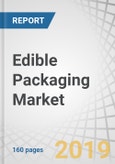The edible packaging market is estimated at USD 527 million in 2019 and projected to grow at a CAGR of 4.3%, to reach USD 679 million by 2025. The growth of the edible packaging market is driven by factors such as government initiatives, water conservation activities, enhancement of production, and decrease in production cost. This market is also driven by factors such as the ban on single-use plastics, growing environmental and sustainability concerns, increased shelf-life of fresh products without refrigeration, and development of new plant- and microorganism-based sources.
The seaweed and algae sources led the market with the largest share in 2019.
On the basis of raw material, the edible packaging market is classified into seaweed and algae, polysaccharides, lipids, and others, which include surfactants, composites, and carbohydrates. Seaweeds have emerged as a key raw material in edible packaging, which can be attributed to the inherent attributes of seaweeds as an edible source.
Seaweeds have high fiber and vitamin content, which aid in the development of seaweed into packaging without the requirement for additional chemical compounds. Given the biodegradable properties of seaweed, it can even be disposed of without any further environmental implications. Seaweed can also be grown with minimal resource support by negating requirements for water, fertilizers, and other key resources.
Beverages accounted for the largest share of the edible packaging market in 2019.
Based on end use, the use of edible packaging in beverages was observed to hold the dominant share in the edible packaging market. Beverages have emerged as a key area for growth in the market. This is primarily driven by water-soluble alternatives to standard plastic packaging. Products including water, juices, and even alcoholic beverages have emerged as the key areas for adoption in the edible packaging landscape.
Products such as Ooho have gained widespread popularity among consumers as a water-pod, which can be ingested. Similarly, foodservice outlets are utilizing water-soluble packaging solutions in their everyday operations in an effort to reduce waste.
Plant-based edible packaging holds the dominant market share, by source.
On the basis of source, the plant-based segment is expected to hold the largest market share between 2019 and 2025. Plant-based sources have gained widespread popularity among manufacturers as a reliable source for the development of edible packaging solutions. Different types of plant-based sources, including fibrous vegetables, starch, carbohydrates, and seaweed have emerged as popular sources of edible packaging.
Ingredients such as cassava have also been integrated into the process and are viewed as taste-neutral solutions to packaging. Seaweed-based sources have also been adapted into paper-packaging forms and witness widespread acceptance in foodservice industries.
High growth is projected in the Asia Pacific edible packaging market.
The Asia Pacific market is projected to be the fastest-growing market for the period considered for this study due to the strong potential for edible packaging solutions, which are being developed in the region. Edible packaging manufacturers see the region as a key launchpad for their offerings, given the growing resistance toward single-use plastics and government reforms toward packaging and waste generation. The region also hosts a strong manufacturing hub for the seaweed industry, which represents a key area for growth in the edible packaging market.
Break-up of Primaries:
- By Company Type: Tier 1 - 70 %, Tier II - 25%, and Tier III – 5%
- By Designation: C Level - 50%, D Level - 30%, and Others* - 20%
- By Region: Asia Pacific – 45%, North America - 21%, Europe - 12%, South America – 12%, and RoW - 10%
Research Coverage:
The report segments the edible packaging on the basis of end use, packaging process, source, raw material, and region. In terms of insights, this report has focused on various levels of analyses - competitive landscape, end-use analysis, and company profiles, which together comprise and discuss views on the emerging & high-growth segments of the global edible packaging, high-growth regions, countries, government initiatives, drivers, restraints, opportunities, and challenges.
Reasons to buy this report:
- To get a comprehensive overview of edible packaging
- To gain wide-ranging information about the top players in this industry, their product portfolios, and key strategies adopted by them
- To gain insights about the major countries/regions in which the edible packaging market is flourishing
Table of Contents
Executive Summary
Companies Mentioned
- Monosol LLC
- JRF Technology
- Evoware
- Tipa Corp.
- Nagase America
- Notpla Ltd.
- Avani (Indonesia)
- Wikicell Designs
- Amtrex Nature Care Pvt. Ltd.
- EnviGreen Biotech Pvt. Ltd.
- Regeno Bio-Bags
- Devro Plc
- Apeel Sciences
- Coolhaus
- Do Eat
- Ecoactive
- Mantrose UK Ltd.
- Dental Development Systems LLC
- Tomorrow Machine
- Lactips
Methodology

LOADING...








